James Webb Space Telescope Jwst
- All
- News
- Videos
- Web Stories
-

Reflective Clouds And Metallicity, All About Exotic Atmosphere Of Rare "Ultra-Hot Neptune"
- Thursday November 27, 2025
- Science | Edited by Srishti Singh Sisodia
With temperatures reaching almost 2,000 degrees Celsius on its dayside, LTT 9779 is one of the few known planets in the "hot Neptune desert".
-
 www.ndtv.com
www.ndtv.com
-

James Webb Telescope May Have Discovered Universe’s Earliest Supermassive Black Hole
- Tuesday November 25, 2025
- Written by Gadgets 360 Staff
James Webb may have discovered the universe’s earliest supermassive black hole in galaxy GHZ2. Observations reveal high-energy emission lines, challenging existing models of rapid black hole and galaxy growth. Upcoming JWST and ALMA studies aim to confirm AGN activity and refine our understanding of early cosmic evolution.
-
 www.gadgets360.com
www.gadgets360.com
-

NASA May Have Detected Oldest Stars In Universe Formed After Big Bang
- Friday November 21, 2025
- Feature | Edited by Abhinav Singh
NASA's James Webb Space Telescope may have detected the universe's oldest Population III stars in galaxy LAP1-B, 13 billion light-years away.
-
 www.ndtv.com
www.ndtv.com
-

James Webb Space Telescope May Have Spotted the Universe’s First Stars, Astronomers Say
- Wednesday November 19, 2025
- Written by Gadgets 360 Staff
Astronomers using the James Webb Space Telescope have detected a distant, metal-poor galaxy whose unusually massive, ultraviolet-bright stars match the expected signatures of Population III — the universe’s first stars. Through the help of gravitational lensing and Webb’s infrared sensitivity, researchers observed light from just 800 million ...
-
 www.gadgets360.com
www.gadgets360.com
-

James Webb Telescope May Have Spotted First Generation of Stars in the Universe
- Sunday November 16, 2025
- Written by Gadgets 360 Staff
Astronomers using JWST may have discovered Population III stars in cluster LAP1-B, offering new insights into early galaxy formation and the universe’s first luminous objects. JWST observations suggest Population III stars may have formed 13 billion years ago, helping trace early galaxies. These stars might be building blocks for larger galaxies ...
-
 www.gadgets360.com
www.gadgets360.com
-

Webb Finds Phosphorus-Bearing Gas in an Ancient Brown Dwarf
- Monday November 10, 2025
- Written by Gadgets 360 Staff
NASA’s James Webb Space Telescope has detected phosphine (PH₃) in the atmosphere of the ancient brown dwarf Wolf 1130C, about 54 light-years away in Cygnus. This marks the first confirmed detection of a phosphorus-bearing gas in such a metal-poor object. The finding surprises astronomers, as phosphine was previously undetected in similar brown ...
-
 www.gadgets360.com
www.gadgets360.com
-

NASA's James Webb Space Telescope Telescope Challenges Old Theories on Mini-Neptune Worlds
- Friday November 7, 2025
- Written by Gadgets 360 Staff
New models suggest mini-Neptunes—planets smaller than Neptune with thick gas envelopes—may have solid rocky surfaces instead of molten magma. Data from NASA’s JWST revealed high-pressure atmospheres capable of compressing molten rock into solid crusts. This discovery challenges earlier assumptions and offers key insights into exoplanet compos...
-
 www.gadgets360.com
www.gadgets360.com
-

NASA’s JWST Produces First-Ever 3D Map of Distant Planet WASP-18b
- Monday November 3, 2025
- Written by Gadgets 360 Staff
NASA’s James Webb Space Telescope has created the first-ever 3D atmospheric map of an exoplanet, revealing the extreme conditions on WASP-18b, an “ultra-hot Jupiter” located 400 light-years away. Using infrared eclipse mapping, scientists discovered a scorching hotspot over 2,700 °C where water molecules are breaking apart. This groundbreaki...
-
 www.gadgets360.com
www.gadgets360.com
-

James Webb Telescope Finds Early Universe Galaxies Were More Chaotic Than We Thought
- Thursday October 23, 2025
- Written by Gadgets 360 Staff
The James Webb Space Telescope has revealed that galaxies in the early universe were far more chaotic and unstable than once believed. A new study shows that gas turbulence and intense star formation disrupted young galaxies, reshaping scientists’ understanding of how galaxies evolved into the structured systems seen today.
-
 www.gadgets360.com
www.gadgets360.com
-

James Webb Telescope Uncovers the Turbulent Birth of the First Galaxies
- Saturday October 25, 2025
- Written by Gadgets 360 Staff
Using JWST data, astronomers analyzed more than 250 galaxies from the universe’s first 1.5 billion years and found most were chaotic, with gas swirling in all directions. Only a few showed early signs of ordered rotation. The findings reveal how intense star formation and gravitational turbulence gave way to stability, transforming the early univ...
-
 www.gadgets360.com
www.gadgets360.com
-

James Webb Space Telescope Detects Phosphine on Brown Dwarf Wolf 1130C
- Thursday October 9, 2025
- Written by Gadgets 360 Staff
Using the James Webb Space Telescope, scientists have detected phosphine gas in the atmosphere of the brown dwarf Wolf 1130C, about 54 light-years away. The finding suggests phosphine can form in extreme, non-biological environments, challenging its status as a potential biomarker and reshaping how scientists search for alien life.
-
 www.gadgets360.com
www.gadgets360.com
-

JWST Reveals Stunning New Details About M87’s Supermassive Black Hole Jet
- Saturday October 4, 2025
- Written by Gadgets 360 Staff
Recent images captured by the James Webb Space Telescope (JWST) are the clearest ever pictures of the jet arriving from the massive black hole in the galaxy named Messier 87 (M87). There are clear details in the image shot by the telescope, which show the change of brightness, shape and the jet that is usually in disguise. As per scientists, this d...
-
 www.gadgets360.com
www.gadgets360.com
-

Not Like Venus Or Mars, Distant Exoplanet May Have Atmosphere Like Earth's
- Friday September 19, 2025
- World News | Edited by NDTV News Desk
A distant exoplanet might have an atmosphere similar to Earth's, early observations from the James Webb Space Telescope (JWST) suggest. It is part of a group of planets orbiting a star called TRAPPIST-1, about 40 light-years away from Earth.
-
 www.ndtv.com
www.ndtv.com
-

Tiny Red Dots Spotted By NASA’s James Webb Telescope Could Be Black Hole Stars
- Thursday September 25, 2025
- Written by Gadgets 360 Staff
NASA’s James Webb Space Telescope revealed mysterious “little red dots” that seem too bright and mature for their age. A new study suggests they may be black hole stars—giant hydrogen spheres powered by black holes—helping explain the rapid growth of early supermassive black holes.
-
 www.gadgets360.com
www.gadgets360.com
-

James Webb Spots Bizarre Planet-Forming Disk Full of Carbon Dioxide
- Friday September 5, 2025
- Written by Gadgets 360 Staff
The James Webb Space Telescope has spotted a bizarre planet-forming disk dominated by carbon dioxide where water is almost absent. This rare finding, in star system XUE 10 within NGC 6357, challenges current models of planetary formation and may reshape our understanding of habitable worlds.
-
 www.gadgets360.com
www.gadgets360.com
-

Reflective Clouds And Metallicity, All About Exotic Atmosphere Of Rare "Ultra-Hot Neptune"
- Thursday November 27, 2025
- Science | Edited by Srishti Singh Sisodia
With temperatures reaching almost 2,000 degrees Celsius on its dayside, LTT 9779 is one of the few known planets in the "hot Neptune desert".
-
 www.ndtv.com
www.ndtv.com
-

James Webb Telescope May Have Discovered Universe’s Earliest Supermassive Black Hole
- Tuesday November 25, 2025
- Written by Gadgets 360 Staff
James Webb may have discovered the universe’s earliest supermassive black hole in galaxy GHZ2. Observations reveal high-energy emission lines, challenging existing models of rapid black hole and galaxy growth. Upcoming JWST and ALMA studies aim to confirm AGN activity and refine our understanding of early cosmic evolution.
-
 www.gadgets360.com
www.gadgets360.com
-

NASA May Have Detected Oldest Stars In Universe Formed After Big Bang
- Friday November 21, 2025
- Feature | Edited by Abhinav Singh
NASA's James Webb Space Telescope may have detected the universe's oldest Population III stars in galaxy LAP1-B, 13 billion light-years away.
-
 www.ndtv.com
www.ndtv.com
-

James Webb Space Telescope May Have Spotted the Universe’s First Stars, Astronomers Say
- Wednesday November 19, 2025
- Written by Gadgets 360 Staff
Astronomers using the James Webb Space Telescope have detected a distant, metal-poor galaxy whose unusually massive, ultraviolet-bright stars match the expected signatures of Population III — the universe’s first stars. Through the help of gravitational lensing and Webb’s infrared sensitivity, researchers observed light from just 800 million ...
-
 www.gadgets360.com
www.gadgets360.com
-

James Webb Telescope May Have Spotted First Generation of Stars in the Universe
- Sunday November 16, 2025
- Written by Gadgets 360 Staff
Astronomers using JWST may have discovered Population III stars in cluster LAP1-B, offering new insights into early galaxy formation and the universe’s first luminous objects. JWST observations suggest Population III stars may have formed 13 billion years ago, helping trace early galaxies. These stars might be building blocks for larger galaxies ...
-
 www.gadgets360.com
www.gadgets360.com
-

Webb Finds Phosphorus-Bearing Gas in an Ancient Brown Dwarf
- Monday November 10, 2025
- Written by Gadgets 360 Staff
NASA’s James Webb Space Telescope has detected phosphine (PH₃) in the atmosphere of the ancient brown dwarf Wolf 1130C, about 54 light-years away in Cygnus. This marks the first confirmed detection of a phosphorus-bearing gas in such a metal-poor object. The finding surprises astronomers, as phosphine was previously undetected in similar brown ...
-
 www.gadgets360.com
www.gadgets360.com
-

NASA's James Webb Space Telescope Telescope Challenges Old Theories on Mini-Neptune Worlds
- Friday November 7, 2025
- Written by Gadgets 360 Staff
New models suggest mini-Neptunes—planets smaller than Neptune with thick gas envelopes—may have solid rocky surfaces instead of molten magma. Data from NASA’s JWST revealed high-pressure atmospheres capable of compressing molten rock into solid crusts. This discovery challenges earlier assumptions and offers key insights into exoplanet compos...
-
 www.gadgets360.com
www.gadgets360.com
-

NASA’s JWST Produces First-Ever 3D Map of Distant Planet WASP-18b
- Monday November 3, 2025
- Written by Gadgets 360 Staff
NASA’s James Webb Space Telescope has created the first-ever 3D atmospheric map of an exoplanet, revealing the extreme conditions on WASP-18b, an “ultra-hot Jupiter” located 400 light-years away. Using infrared eclipse mapping, scientists discovered a scorching hotspot over 2,700 °C where water molecules are breaking apart. This groundbreaki...
-
 www.gadgets360.com
www.gadgets360.com
-

James Webb Telescope Finds Early Universe Galaxies Were More Chaotic Than We Thought
- Thursday October 23, 2025
- Written by Gadgets 360 Staff
The James Webb Space Telescope has revealed that galaxies in the early universe were far more chaotic and unstable than once believed. A new study shows that gas turbulence and intense star formation disrupted young galaxies, reshaping scientists’ understanding of how galaxies evolved into the structured systems seen today.
-
 www.gadgets360.com
www.gadgets360.com
-

James Webb Telescope Uncovers the Turbulent Birth of the First Galaxies
- Saturday October 25, 2025
- Written by Gadgets 360 Staff
Using JWST data, astronomers analyzed more than 250 galaxies from the universe’s first 1.5 billion years and found most were chaotic, with gas swirling in all directions. Only a few showed early signs of ordered rotation. The findings reveal how intense star formation and gravitational turbulence gave way to stability, transforming the early univ...
-
 www.gadgets360.com
www.gadgets360.com
-

James Webb Space Telescope Detects Phosphine on Brown Dwarf Wolf 1130C
- Thursday October 9, 2025
- Written by Gadgets 360 Staff
Using the James Webb Space Telescope, scientists have detected phosphine gas in the atmosphere of the brown dwarf Wolf 1130C, about 54 light-years away. The finding suggests phosphine can form in extreme, non-biological environments, challenging its status as a potential biomarker and reshaping how scientists search for alien life.
-
 www.gadgets360.com
www.gadgets360.com
-

JWST Reveals Stunning New Details About M87’s Supermassive Black Hole Jet
- Saturday October 4, 2025
- Written by Gadgets 360 Staff
Recent images captured by the James Webb Space Telescope (JWST) are the clearest ever pictures of the jet arriving from the massive black hole in the galaxy named Messier 87 (M87). There are clear details in the image shot by the telescope, which show the change of brightness, shape and the jet that is usually in disguise. As per scientists, this d...
-
 www.gadgets360.com
www.gadgets360.com
-

Not Like Venus Or Mars, Distant Exoplanet May Have Atmosphere Like Earth's
- Friday September 19, 2025
- World News | Edited by NDTV News Desk
A distant exoplanet might have an atmosphere similar to Earth's, early observations from the James Webb Space Telescope (JWST) suggest. It is part of a group of planets orbiting a star called TRAPPIST-1, about 40 light-years away from Earth.
-
 www.ndtv.com
www.ndtv.com
-

Tiny Red Dots Spotted By NASA’s James Webb Telescope Could Be Black Hole Stars
- Thursday September 25, 2025
- Written by Gadgets 360 Staff
NASA’s James Webb Space Telescope revealed mysterious “little red dots” that seem too bright and mature for their age. A new study suggests they may be black hole stars—giant hydrogen spheres powered by black holes—helping explain the rapid growth of early supermassive black holes.
-
 www.gadgets360.com
www.gadgets360.com
-

James Webb Spots Bizarre Planet-Forming Disk Full of Carbon Dioxide
- Friday September 5, 2025
- Written by Gadgets 360 Staff
The James Webb Space Telescope has spotted a bizarre planet-forming disk dominated by carbon dioxide where water is almost absent. This rare finding, in star system XUE 10 within NGC 6357, challenges current models of planetary formation and may reshape our understanding of habitable worlds.
-
 www.gadgets360.com
www.gadgets360.com









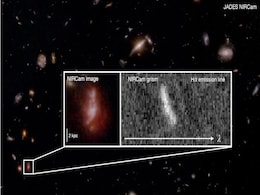

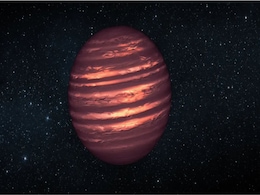
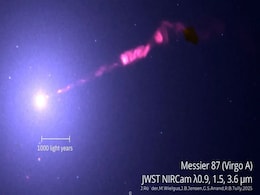
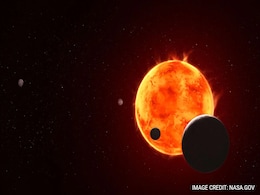
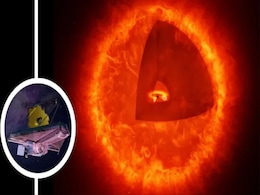
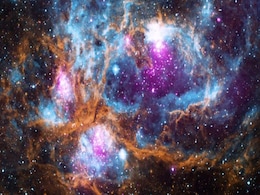
![Gadgets 360 With Technical Guruji: Did You Know? [April 6, 2024] Gadgets 360 With Technical Guruji: Did You Know? [April 6, 2024]](https://c.ndtvimg.com/2024-02/mpconh58_did-you-know_640x480_10_February_24.jpg?downsize=245:163)




